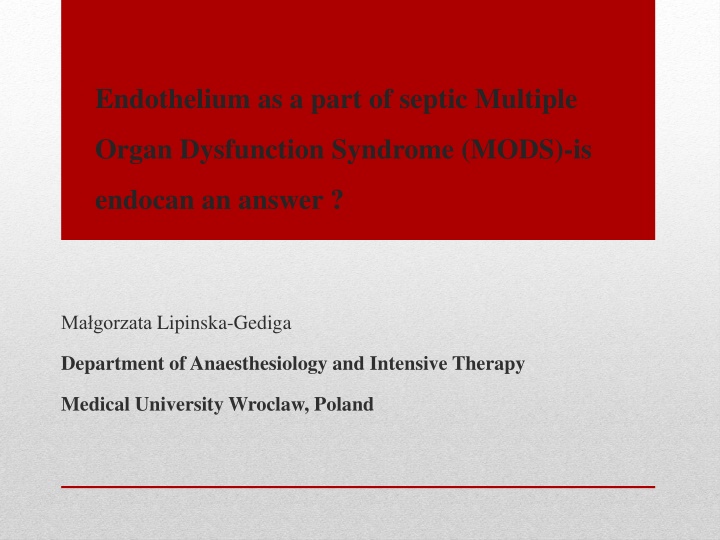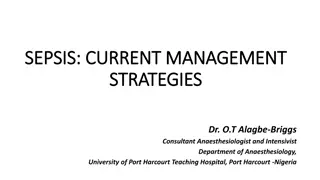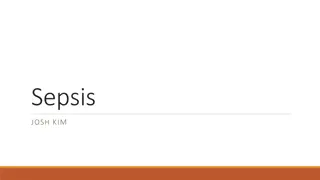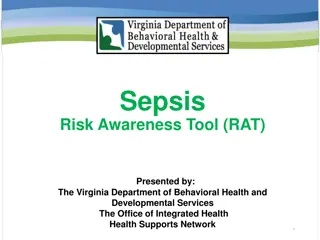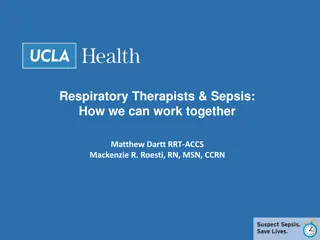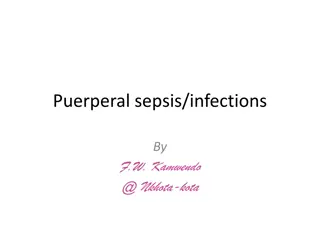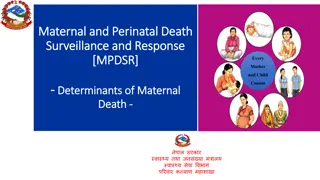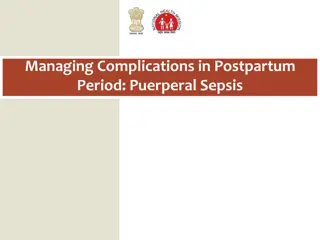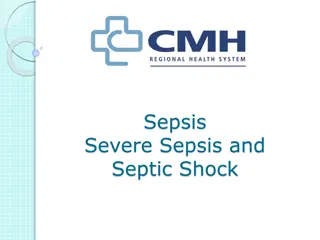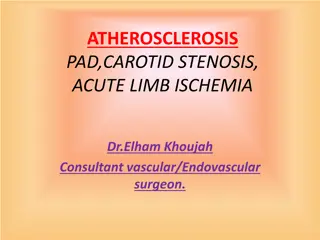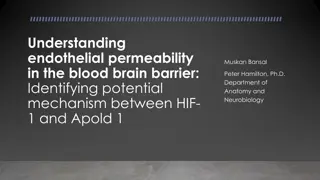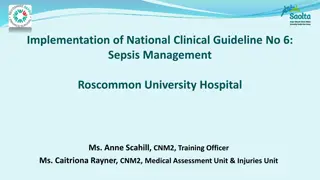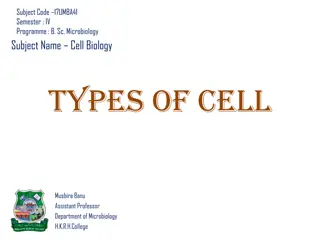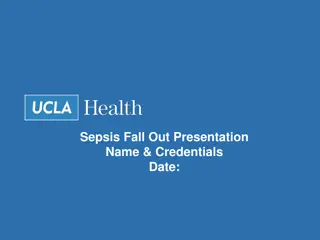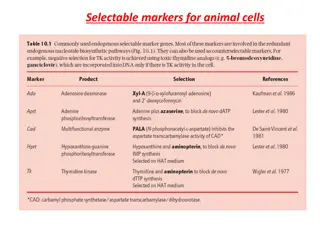Endothelial Cells in Sepsis: Critical Determinants of Host Response
Endothelial cells play a crucial role in sepsis pathophysiology, with activation and dysfunction being key factors. Targeting markers of endothelial activation as biomarkers of sepsis has strong biological rationale. This article discusses the significance of endothelium in septic Multiple Organ Dysfunction Syndrome (MODS), emphasizing its role in the complex host response. The endothelial and capillary system's central role in maintaining organ functions, particularly during sepsis, is highlighted. Consideration of endothelial activation markers as biomarkers is essential for a comprehensive understanding of sepsis pathophysiology.
Download Presentation

Please find below an Image/Link to download the presentation.
The content on the website is provided AS IS for your information and personal use only. It may not be sold, licensed, or shared on other websites without obtaining consent from the author.If you encounter any issues during the download, it is possible that the publisher has removed the file from their server.
You are allowed to download the files provided on this website for personal or commercial use, subject to the condition that they are used lawfully. All files are the property of their respective owners.
The content on the website is provided AS IS for your information and personal use only. It may not be sold, licensed, or shared on other websites without obtaining consent from the author.
E N D
Presentation Transcript
Endothelium as a part of septic Multiple Organ Dysfunction Syndrome (MODS)-is endocan an answer ? Ma gorzata Lipinska-Gediga Department of Anaesthesiology and Intensive Therapy Medical University Wroclaw, Poland
Sepsis is a systemic, deleterious host response to infection leading to severe sepsis (acute organ dysfunction secondary to documented or suspected infection) and septic shock (severe sepsis plus hypotension not reversed with fluid resuscitation) Intensive Care Med (2013) 39:165 228 DOI 10.1007/s00134-012-2769-8
Under resting conditions, endothelial cells exhibit a number of important physiological functions : release tissue-type activator and inhibit platelet aggregation prostacyclin and nitric oxide regulate the transmigration of leukocytes by controlling the expression of adhesion molecules and the production of chemoattractants small amount plasminogen of regulate blood pressure and blood flow by modulating the tone of arterioles inhibit blood coagulation express thrombomodulin, which binds thrombin and Activated protein C (APC), with its cofactor protein S, blocks the cofactors VIIIa and Va of system. by producing the clotting
As one of the largest organs, the endothelial and capillary system occupies a central role in the homeostasis of organ functions. However, one of the largest and most important organs, is not routinely tracked in the daily clinical routine In sepsis, endothelial activation and dysfunction are critical determinants of the host response and represent an explanation for the complex sepsis pathophysiology ( Iba et al. 2005; Shapiro et al. 2010,Paulus 2011).Given this central place of the endothelium, there is a strong biologic rationale for targeting markers of endothelial activation as biomarkers of sepsis. (Pierrakos and Vincent 2010, Paulus 2011, Xing 2012, De Backer 2014).
Endocan, also called endothelial cell-specific molecule-1, is a soluble 50 kDa dermatan sulfate proteoglycan that is secreted from pulmonary and kidney vascular endothelial cells [Bechard et al. 2001, Lassalle et al.1996]. Endocan is stable at low levels in the blood and was detected in the serum of healthy subjects at an average concentration of 1.08 ng/ml. ESM-1 mRNA is regulated by the cytokines, TNF induced accumulation of ESM-1 mRNA early;(Berchard et al. 2000), it was detectable at the second hour and peaked at the 18th hour of TNF incubation. The spontaneous as well as TNF -induced secretion of ESM-1 is strongly inhibited by IFN . Endocan was shown to inhibit the interaction between intercellular adhesion molecule-1 (ICAM-1) and the integrin (lymphocyte function- associated antigen-1) LFA-1 on leukocytes, and can modulate LFA-1 mediated leukocyte functions, such as the firm adhesion of leukocytes to the endothelium and the leukocytes transmigration (Bechard et al. 2000)
Study group comprised twenty two patients with septic shock, admitted to the Department of Anesthesiology and Intensive Therapy of Wroclaw Medical University, Poland. Patients with cardiogenic shock and other acute circulatory failure not induced by infection were excluded from the study. The study group patients were retrospectively divided into the survivors (n = 15) and non-survivors (n = 7) subgroups. The diagnosis of septic shock was performed according to the 2001 Consensus Conference Criteria .This study is observational and prospective. The status of clinical patients was assessed with the Acute Physiology and Chronic Health Evaluation II (APACHE II) score [Knaus et al. 1985] on admission to the ICU, and the extent of multiple organ failure was evaluated using the Sequential Organ Failure Assessment (SOFA) score [Vincent et al.1996] on admission, and on the 2nd, 3rd, and 5th days. Blood was drawn on admission, and on the 2nd, 3rd, and 5th days.
The data were analyzed with non-parametric test (MannWhitney U-test) to compare the two groups. The APACHE II and SOFA score values are presented as the mean standard deviation (SD). A P value 0.05 was considered to be statistically significant. Correlation analysis with continuous data was conducted using Pearson s correlation test (r). All analyses were performed using the STATISTICA data analysis software system, version 10. StatSoft, Inc. (2011). www.statsoft.com
Control group-adult patients undergoing valve replacement or coronary artery bypass grafting under cardiopulmonary bypass (ECC) were consecutively included in the study. Endocan levels were measured before and directly after surgery, next on the 1st and 2nd postoperative day at the ICU. The control group consisted of 19 patients (12 men, 7 women, mean age 67 years), this group presented no multiple organ failure in postoperative period and the ICU stay didn t exceed 2 days. Cardio (ECC) group n=19 2,10 (0,64 7,9) Septic group n=22 P value Endocan1st 5,25 (0,58 13,0) 0,0009 Endocan2nd 5,06 (0,97 6,9) 5,09 (0,58 12,0) 0,24 Endocan3rd 4,80 (1,09 11,0) 2,36 (0,65 10,0) 0,08 Endocan4th 3,1 (1,0 10,7) 2,01 (0,58 12,0) 0,68
APACHE II and SOFA score in septic shock group Survivors N=15 21,5 5,41 10,85 2,53 8,14 1,87 6,07 3 ,19 4,33 3,04 Non-survivors N=7 28,66 7,36 13,66 3,07 12,16 3,18 11,00 6,27 12,00 5,29 P value APACHE II 1st day SOFA 1st day SOFA 2nd day SOFA 3rd day SOFA 5th day 0,025 0,048 0,002 0,04 0,009 Endocan (ng/ml) in septic shock group Survivors N=15 Non-survivors N=7 P value Endocan1st day Endocan2nd day Endocan3rd day Endocan5th day 4,46 (0,58 9,57) 5,34 (0,58 10,8) 2,26 (0,65 10,0) 1,76 (0,58 8,00) 7,15 (2,8 13,0) 4,85 (2,6 12,0) 4,0 (2,34 10,0) 10,8 (1,56 12,0) 0,13 0,52 0,19 0,03
Cardio (ECC) group n=19 2,10 (0,64 7,9) 5,06 (0,97 6,9) 4,80 (1,09 11,0) 3,1 (1,0 10,7) Septic survivors n=15 P value Endocan1st Endocan2nd Endocan3rd Endocan4th 4,46 (0,58 9,57) 5,34 (0,58 10,8) 2,26 (0,65 10,0) 1,76 (0,58 8,00) 0,006 0,6 0,005 0,25 Cardio (ECC) group n=19 2,10 (0,64 7,9) 5,06 (0,97 6,9) 4,80 (1,09 11,0) 3,1 (1,0 10,7) Septic non-survivors n=7 7,15 (2,8 13,0) 4,85 (2,6 12,0) 4,0 (2,34 10,0) 10,8 (1,56 12,0) P value Endocan1st Endocan2nd Endocan3rd Endocan4th 0,002 0,38 0,88 0,20
Procalcitonin (PCT) is a prohormone of calcitonin consisting of 114 to 116 amino acid, PCT originates from the calcitonin-I (CALC-I) gene on chromosome 11.Under physiological conditions serum levels are below 0.5 ng/ml. A microbial infection induces an ubiquitous increase in CALC-I gene expression and a significant release of CTpr from all tissues and cell types (M ller, 2001 ) . Whang and et. al considers that PCT is a secondary mediator intensifying, rather than initiating, the septic response (Whang, 2000). According to SSCIG 2013 (Dellinger PCT is used as a diagnostic marker of sepsis, monitoring its 2013) course and therapeutical efficacy.
Correlation between the procalcitonin (PCT) and endocan levels on admission in septic survivors group r = 0,535, p=0,05 180 160 140 120 PCT [ng/ml] 100 80 60 40 20 0 -20 0 2 4 6 8 10 Endocan [ng/ml]
Correlation between the endocan and WBC on 2-nd day after research in septic survivors group r = 0,577, p=0,05 35 30 25 WBC [109 /L] 20 15 10 5 0 0 4 6 8 10 12 2 Endocan [ng/ml]
Based on the preliminary results, the serum endocan is usually only slightly induced in the course of the time-limited inflammatory response (cardiac surgery) The highest values of endocan were observed in non-survivors (n=7) and was directly associated with the highest APACHE II and SOFA score results, reflecting the clinical status and progress of multiple organ failure in this group Prognostic value ? Correlations? The research is ongoing
